When I was a little girl in school, my school report will often end with a comment from the teacher, “always drawing in class”. However school became more demanding and like most schoolchildren we focused on our grades, homework and the really important things, which I have since forgotten.
So attending a Double Doodle Play class in midlife was nostalgic and I was hopeful that somewhere, somehow I would be able to bring out some natural creative abilities and the little old me that was left behind a long time ago.
Double Doodle Play is a whole brain learning approach using both eyes and two-handed movements simultaneously to create artistic expressions.
It was created by Gail Dennison, an artist and co-founder; with her husband, Dr Paul Dennison; of Educational Kinesiology and Brain Gym movements.
In the Double Doodle Play Handbook, the Dennisons wrote, “We learn to see as we learn to move. Our hand movements teach us how to centralize our vision, and this is centralized vision – the ability to use our two eyes together in the visual midfield – is an integral part of our focusing system, our ability to give our full attention to one thing at any given time.”
That is so true.
At the beginning of the course when I was asked to use both hands to draw circles, I found that my eyes followed the movements of my right hand which was doing fine as I am right-handed. It was automatic.
However as we had to use both hands to draw the circles, I found myself looking at my left hand. It was a conscious effort from me and I realised that when I was concentrating on and looking at what my left hand was doing, my right hand was not doing well at all.
So I was shifting my gaze left and right. It hit me that I was heavily dependent on my eyes. Physically and mentally, to draw with both hands took quite a bit of effort. I could feel it in my left and right pencil grips. The right grip felt kind of confused – to wait or not to wait while my left hand felt kind of out of control and weak.
My vision was always focused on the hand that was being used and not on the total picture, which was the circles by both hands.
Thankfully, I had my happy ending, as by the end of the 8-hour course, I was using both hands simultaneously with relative ease. There were odd looking flowers and things but, I was satisfied.
Drawing with both hands simultaneously and seeing with both eyes actually open up new ways for our brains to experience and relate to things around us because it involves experimentation and exploration.
In the course, I learnt about the “Five key Movements of the Hands and Eyes”. On a piece of blank paper taped to the table, I did ‘Circles ‘( a bit like whorls) and ‘Sweeps’ (rather like starburst). These helped with my saccadic eye movements – this is the eyes moving in small, rapid, automatic movement as they shift attention from one point of focus to another – which we use for reading, looking at a picture, even at a landscape or generally things within our central vision.
Check out http://www.scholarpedia.org/article/Human_saccadic_eye_movements to find out more about what our eyes do when they skim or read. Interesting stuff.
Then, we moved to ‘Tapping’ and ‘Notching’ where the hand-movements support eye pointing, basically the way the eyes focus, glance, rest or pause at a point as well as to discriminate the lines and angles. The fifth hand movement is called ‘Meandering’ which combines the saccadic eye movement and eye-pointing.
After the course, I taught Nicholas the Five Key Movements (5KM) and he has caught on quite fast and is creating pictures with them.
The beauty of Double Doodle Play is that it provides a framework and then allows the person to express in ways that are meaningful to the person.
I remember my instructor, Glenys Leadbeater, walking around the class with a thoughtful smile on her face. She explained that the class is about discovering our creativity (sometimes hidden) which in turn would give us greater freedom in making natural choices.
Talking about creativity, I have also used the Double Doodle Play with my small English Language class.
My students love the Meandering because of the playfulness and possibilities. I would start with a Meandering and ask one of the students (all hands will go up) to complete it. Then there would be a huge discussion of what the picture represented, after which everyone would write an essay about their perception of the picture.
Everyone would read his/her story aloud to the class. There would be all kinds of stories, unheard of animals, gross and impossible situations and a spurt of new words. Sometimes, I would ask each student to draw his own Meandering and write a story around it.
In the handbook, Gail Dennison, the author wrote that Double Doodle Play supports academic and life skills such as eye-hand coordination, spatial awareness, creativity, ability to see similarities and discern distinction, noticing, relaxed attention, self-awareness, concentration and sustained awareness, curiosity, language development and, choice making, among others.
At the end of the day when I looked through the list, I realised that I could tick most of them.
As beauty is in the eye of the beholder, we had all produced great pieces of art. By the way, what I have described about Double Doodle Play is only a quarter of what is taught in the course.
There is no prerequisite or age limit. The course I attended had a little girl of 8 or 9 years of age. Check out available courses at Braingym.org or breakthru.academy
With Nicholas, I would not know what he is thinking but I can see that he has sustained attention and focus and the spatial ability to fill up the blank piece of paper with his imagination; drawing circles, star-burst, dots, meandering and notches. He is also making choices on his own and I might add, discovering his own creativity.
“THE TRUE SIGN OF INTELLIGENCE IS NOT KNOWLEDGE BUT IMAGINATION” – ALBERT EINSTEIN


